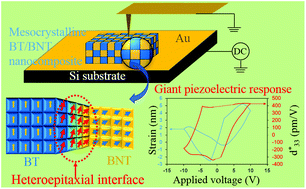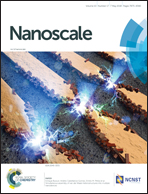Anomalous piezoelectric response of ferroelectric mesocrystalline BaTiO3/Bi0.5Na0.5TiO3 nanocomposites designed by strain engineering†
Abstract
Mesocrystals, a new class of unique materials, not only have potential properties based on the individual nanocrystals but also have a single-crystal-like function. Here, we report a ferroelectric mesocrystalline BaTiO3/Bi0.5Na0.5TiO3 (BT/BNT) nanocomposite synthesized from a layered titanate H1.07Ti1.73O4 (HTO) by an ingenious two-step topochemical process for the first time. The BT/BNT nanocomposite is constructed from well-aligned BT and BNT nanocrystals with the same crystal-axis orientation. The BT/BNT heteroepitaxial interface in the nanocomposite is promising for an enhanced piezoelectric performance by using lattice strain engineering, which gives a giant piezoelectric response with a  value of 408 pm V−1. The introduced lattice strain at the BT/BNT heteroepitaxial interface causes transitions of pseudo-paraelectric BT and BNT nanocrystals to ferroelectric nanocrystals in the mesocrystalline nanocomposite, which enlarges ferroelectric, piezoelectric and dielectric responses. The lattice strain also results in the elevated Curie temperatures (Tc) of BT and BNT and a new intermediate phase transition.
value of 408 pm V−1. The introduced lattice strain at the BT/BNT heteroepitaxial interface causes transitions of pseudo-paraelectric BT and BNT nanocrystals to ferroelectric nanocrystals in the mesocrystalline nanocomposite, which enlarges ferroelectric, piezoelectric and dielectric responses. The lattice strain also results in the elevated Curie temperatures (Tc) of BT and BNT and a new intermediate phase transition.



 Please wait while we load your content...
Please wait while we load your content...